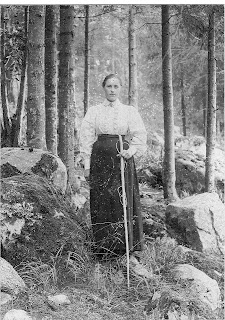The name "Rose" has always been a favorite of mine because of the images created in my imagination of breathtaking blossoms and fragrant scents. I like the name "Rose O'Neill" for its Irish sound, too.
Rose, best known for her Kewpie illustrations, was born into a pleasantly wealthy family on June 25, 1874. Father owned a book store and art gallery in Wilkes-Barre, PA. Unfortunately, Father wasn't a good businessman or a good manager. Meemie (Mother), who had been a teacher before marriage, loved music and often gave piano lessions as well as home schooled Rose and her older brother, Hughie.
Life was good in Wilkes-Barre until 1878 when Father lost the bookstore and decided to solve the family's financial problems by moving them out west to a sod house in Nebraska. It was a hard life especially when compared the to comforts of their old home.
 |
| Rose O'Neill Book Journal Page |
Rose drew all the time and enjoyed drawing the elves and fairies of Father's stories. During these years, the family increased in numbers as new babies were born, and they were often evicted from their rented homes because of Father's inability to manage the family money. Several times he couldn't pay the tuition for Rose's schooling so she would be forced to leave. He did, however, take her to the theater when he could because he had decided that Rose would make a splendid actress.
The family moved to Omaha, and Rose did land a part with a traveling troop of actors when she was 14 years old. The next year she again traveled with a troop, but she did illustrations as well and decideded that her future wasn't in acting.
In 1893, Father decided that Rose would have more opportunity in NYC than in Omaha, so he deposited her there and returned to the family in Nebraska. At this particular time, there was a demand for illustrator/painters so commissions kept Rose quite busy. She sent the money she made home to support the family.
After about a year, Rose returned to her family who were now living in the Ozarks in a place they named Bonniebrook. Rose loved it there and never returned to live in New York permantly.
In 1909, the
Ladies Home Journal introduced her Kewpies and their motto, "do good deeds in a funny way." The Kewpies were a tremendous success with dolls being sold by 1914. All in all, Rose created some 5,500 illustrations for books, magazines, and newspapers.
Rose married twice but had no children of her own. She transformed Bonniebrook into her "dream home" where she supported her family retiring in 1939. Rose died a few years later in 1944.
Linda Brewster wrote a book entitled,
Rose O'Neill the Girl Who Loved to Draw. Even though the book is written for a young audience, it is filled with a few examples of artwork by Ms. Brewster and many pieces of Rose's lovely work. She was Rose O'Neill...America's first woman comic artist.
So remember the ladies.
Carol




